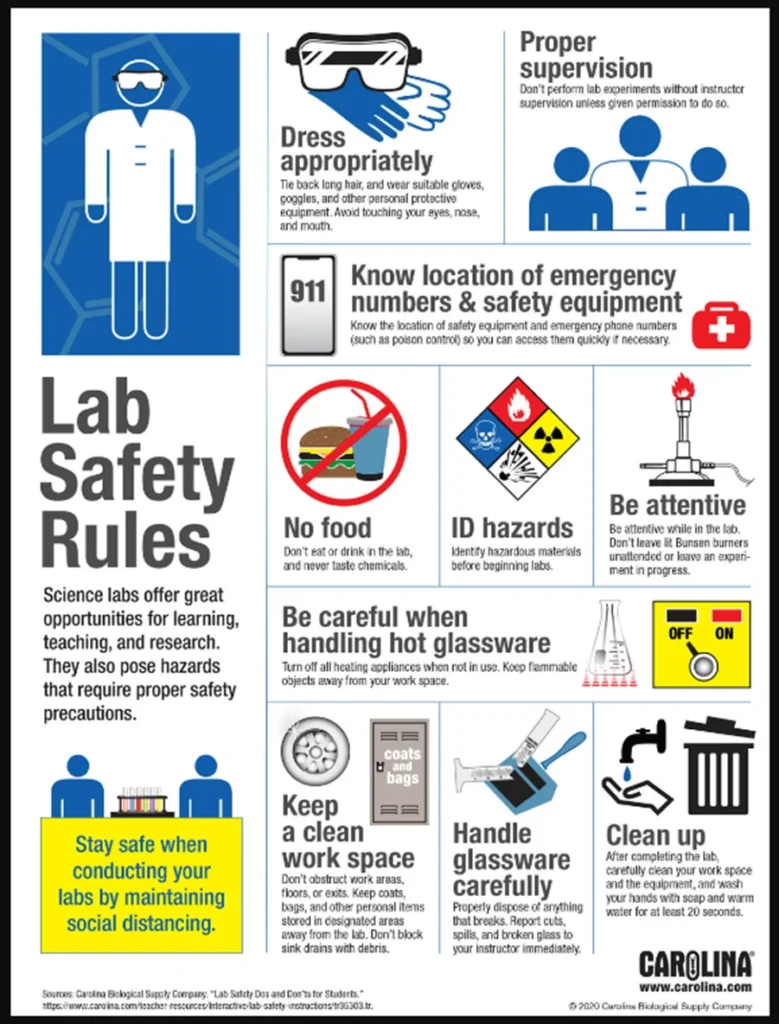Ensuring laboratory safety is crucial in scientific research across all fields, be it chemistry, biology, physics, or others.
It’s imperative to prioritize the safety of researchers and the environment.
This article delves into the significant reasons highlighting the paramount importance of laboratory safety in research.
Maintaining Safety in Laboratory for Scientific Research

1. Prepare for emergencies
In case of an emergency, it’s crucial for researchers to be familiar with emergency response protocols. Laboratory personnel should provide basic information about emergencies, including contact numbers for different types of emergencies.
Accidental spills or releases of hazardous materials can pose risks to people in the lab, work surfaces, and the environment.
Researchers should know how to handle such spills, including wearing necessary protective clothing, removing contaminated clothing promptly, and washing any skin contact with water.
They should also know the location and proper use of spill control kits and use them as needed.
2. Preserving Human Lives
The utmost importance of laboratory safety lies in safeguarding human lives. Laboratories often store hazardous materials and equipment, posing significant risks to researchers and those nearby.
Accidents can result in injuries, illnesses, or even fatalities. Implementing safety measures like wearing personal protective equipment (PPE), maintaining cleanliness, and adhering to protocols greatly reduces harm risk.
3. Reducing Accident Risks
Laboratories contain potentially hazardous substances such as chemicals, biological agents, and radioactive materials.
Experiments involving high temperatures, pressures, or other variables can lead to accidents if mishandled.
Adhering to safety guidelines, using proper equipment, and maintaining vigilance minimizes accident risks, ensuring safety for researchers and the environment.
4. Preventing Exposure to Harmful Substances
Many substances used in lab research can be toxic, carcinogenic, or harmful if they contact skin, eyes, or the respiratory system.
Exposure can result in acute or chronic health issues.
Safety measures like proper labeling, storage, and handling of hazardous materials help prevent accidental exposure, safeguarding researchers’ long-term health.
5. Environmental Protection
Lab research often involves chemicals and materials that can harm the environment if not managed responsibly.
Spills, improper disposal, and inadequate containment can lead to soil and water contamination, air pollution, and ecological problems.
Adhering to strict safety procedures ensures research activities don’t harm the environment, promoting sustainable scientific practices.
6. Preserving the Integrity of Research
Lab safety is crucial for maintaining research integrity. Overlooking safety or taking shortcuts can lead to inaccurate or compromised results.
Contamination, equipment failures, or accidents can disrupt experiments, making data unreliable.
Prioritizing lab safety enhances the credibility and validity of research findings, vital for scientific progress.
7. Ethical and Legal Responsibilities
Many countries have legal and ethical obligations concerning lab safety. Researchers and institutions must comply with regulations, codes of conduct, and safety standards.
Non-compliance may result in legal repercussions, financial penalties, or research suspension.
Adhering to these obligations is not just a legal duty but also a moral responsibility.
8. Encouraging a Responsible Culture
Promoting a culture of responsibility and safety is essential in the research community. Encouraging researchers to prioritize safety fosters a collaborative and supportive environment where everyone is vigilant about potential hazards.
Early adoption of good safety habits among aspiring scientists ensures that safety remains a fundamental value in their future research endeavors.
Researchers must be well-equipped in the specific regulations governing the use of equipment and chemicals in their work.
This includes understanding safety protocols, handling procedures, storage requirements, and disposal methods for each item they use.
Compliance with these regulations is essential to ensure a safe and secure working environment, protect the health of personnel, and minimize environmental impact.
Conclusion
In the world of scientific research, laboratory safety isn’t a choice; it’s imperative. Prioritizing human safety, preventing accidents, reducing exposure to dangerous substances, protecting the environment, and upholding research integrity are all paramount.
Every researcher and institution must make laboratory safety a top priority. By doing so, the scientific community can conduct research responsibly and ethically, resulting in valuable discoveries that benefit society while mitigating risks and harm through a focus on safety.



